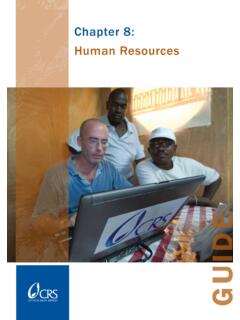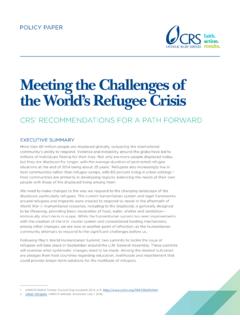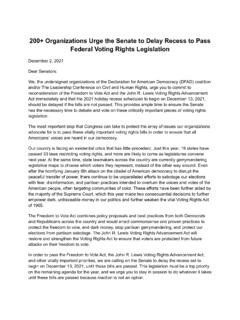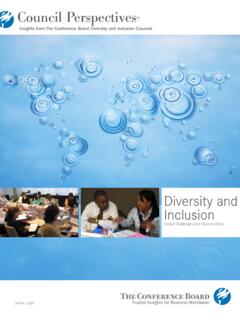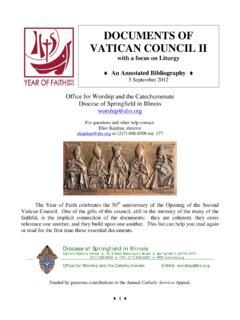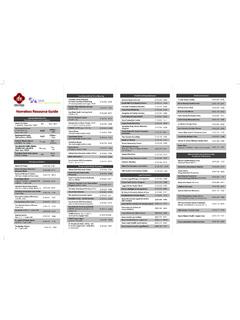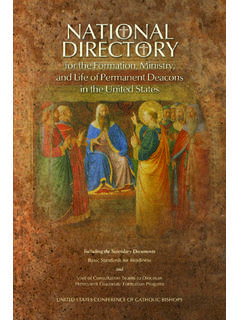Transcription of A Sample Gender Analysis - Catholic Relief Services
1 A Sample Gender AnalysisAbridged VersionANALYSISS ince 1943, Catholic Relief Services has held the privilege of serving the poor and disadvantaged overseas. Without regard to race, creed or nationality, CRS provides emergency Relief in the wake of disasters. CRS works to uphold human dignity and promote better standards of living through development projects in fields such as agriculture, education, health, microfinance, peacebuilding, and water and also works throughout the United States to expand the knowledge and action of Catholics and others interested in issues of international peace and justice.
2 Our programs and resources respond to the Conference of Catholic Bishops call to live in solidarity as one human 2013 Catholic Relief ServicesCRS Ethiopia conducted the Gender Analysis that led to this abridged : 978-1-61492-118-9 ISBN-10: 1-61492-118-0 Cover: women from Sire (Arzi Zone) developing their map of community assets. Trish Ahern/CRSFor any commercial reproduction, please obtain permission from or write to: Catholic Relief Services228 West Lexington StreetBaltimore, MD 21201 3413 USAD ownload this and other CRS publications at Sample Gender ANALYSISA bridged VersionTABLE OF to Use This Document.
3 IvAbbreviations ..ivExecutive Background ..12. Research Livelihoods and Food Insecurity ..11 Main sources of livelihood ..11 Contributing factors to household food insecurity ..11 Coping strategies at the household level ..14 Influence of broader institutional structures ..14 Health and nutrition ..15 Gender Equality and women s Empowerment in Household Livelihoods ..19 Dimension 1: Self-efficacy ..21 Dimension 2: Gendered division of labor ..27 Dimension 3: Access and control over resources and decision-making 31 Degree of Gender Responsiveness in DFAP and PSNP.
4 404. Recommendations ..44 References ..47 Annex 1: Key Gender Definitions and Concepts ..51 Annex 2: The Integral Human Development Framework ..56 Annex 3: Ethiopia Regional Maps ..57 Annex 4: Gender Analytical Tools Adapted by the Gender Analysis ..59 Annex 5: Summary of Focus Group Discussions ..60 Annex 6: Summary Table of Participation of women and Men in Decision-Making at Household and Community Levels by Zone ..61iiiACKNOWLEDGMENTSThis study would not have been possible without the contributions and hard work of many individuals.
5 Thanks to Carlos Sanchez (CRS Head of Programs) and Tesfaye Tilahun (CRS Chief of Party) for their leadership and support, and senior management from Hararghe Catholic Secretariat and Wonji Catholic Church for their commitment to the project. Thanks to Tiruset Haile (CRS Ethiopia Gender Officer) for managing the study, and Addisaelm Ambabye (HCS) and Mesert Teka (WCC) for coordinating the field research. We are grateful to Mary Patricia (Trish) Ahern (CRS) and Lisa Kingston (CRS) for their participation and ongoing support for this project.
6 We acknowledge and appreciate the important and timely research and writing of Dr. Marie-Katherine Waller (independent consultant). We would like to extend our thanks to members of the HCS and WCC research teams for their hard work and commitment. In addition, we wish to thank the many people who reviewed the final report. CRS Ethiopia would especially like to acknowledge the Agency for International Development for funding this study and for its own renewed commitment to promoting Gender equality and female empowerment.
7 Last but not least, we would like to express our gratitude to the Ethiopian men and women , community members, government staff, and others who contributed their time and energy and shared their stories to make this study TO USE THIS DOCUMENTThis document is a condensed version of a full Gender Analysis of a food security program in Ethiopia. We hope that program staff will use this condensed version as a template when conducting their own Gender analyses. The document provides an example of what a Gender Analysis looks like and the questions it seeks to answer as well as how to collect the data, analyze findings, and incorporate those findings into a program strategy.
8 Conducting a Gender Analysis is an important step in helping program staff understand and address Gender inequalities to maximize program results and outcomes and achieve a greater impact in the communities they serve. The full version of this Gender Analysis is available at / Gender %20 Analysis % Catholic Relief ServicesDFAP Development Food Assistance ProgramEH East Hararghe FGD focus group discussionFSTF Food Security Task ForceHCS Hararghe Catholic SecretariatIHD integral human developmentMYAP Multi-Year Assistance ProgramPIM Program Implementation ManualPSNP Productive Safety Net ProgramSILCs savings and internal lending communitiesUSAID Agency for International DevelopmentWASH water.
9 Sanitation and hygieneWCC Wonji Catholic ChurchWHO World Health OrganizationvEXECUTIVE SUMMARYThis case study summarizes a Gender Analysis conducted from June to October 2012 to assess Gender dynamics in household livelihoods in six selected districts (woredas) in Arsi Zone and East Hararghe (EH Zone) of Oromia Region and Dire Dawa Administrative Council, Ethiopia. The purpose was to inform the development of a cross-cutting Gender strategy to ensure women , men, girls and boys equally participate in and benefit from a CRS food security program in Ethiopia the Development Food Assistance Program (DFAP) funded by the Agency for International Development Food for Peace program.
10 DFAP operates within the national Productive Safety Net Program (PSNP), which supports male and female chronically food-insecure households to reach food sufficiency and security. The research is based on primary data collection and Analysis using a Gender -sensitive qualitative and participatory methodology and a wider literature review. A total of 1,276 participants and CRS Ethiopia partner and implementing government partner staff participated in the study with almost equal representation of women and men.



